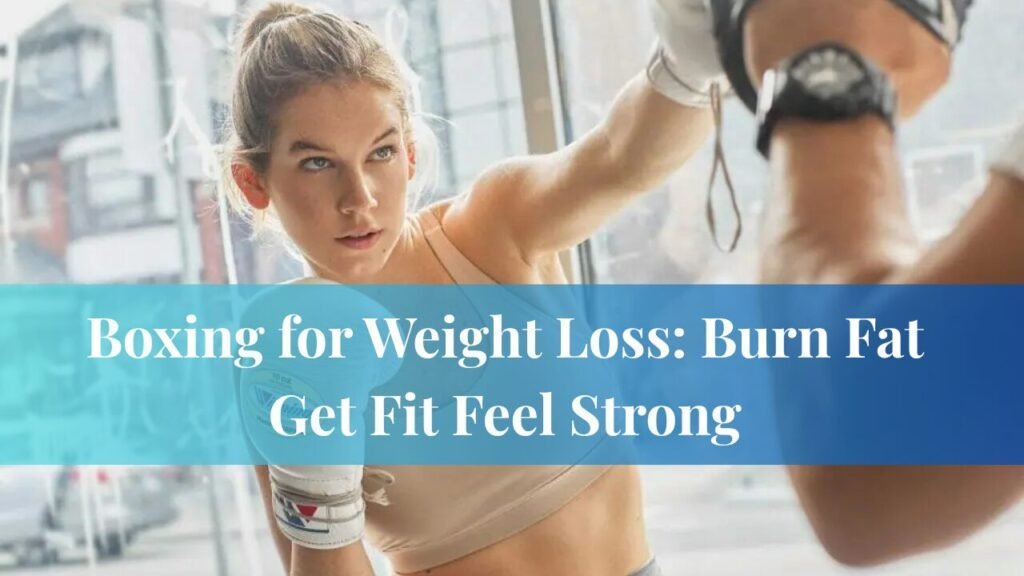Boxing burns fat, builds lean muscle, and boosts your metabolism. This dynamic workout blends cardio, strength training, and high-intensity interval training (HIIT), creating the perfect recipe for fat loss. Within just a few sessions, you can torch calories, tone your body, and feel a noticeable increase in energy levels.
Boxing sessions often combine various fitness elements that accelerate weight loss. Whether you’re throwing jabs or doing footwork drills, you’re engaging multiple muscle groups, increasing your heart rate, and working both your aerobic and anaerobic systems. This makes boxing an efficient, high-impact way to burn calories and lose weight.
Benefits of Boxing for Weight Loss
Boxing is incredibly effective when it comes to torching calories. A single 60-minute session can burn between 600 to 800 or more calories depending on your intensity. This makes it more efficient than many traditional workouts. Boxing routines often follow a HIIT structure, where high-intensity bursts of movement alternate with short periods of rest, which keeps your heart rate up and metabolism firing even after the workout ends.
What sets boxing apart is how it engages your entire body. Punches work your arms and shoulders, while the constant movement engages your legs and core. This full-body activation promotes lean muscle growth and creates a long-lasting afterburn effect. Additionally, the cardiovascular challenge strengthens your heart and lungs, and the mental release helps reduce stress levels, all of which contribute to successful weight loss.
Real-World Experience Michael O’Brien’s Story
Fitness coach Michael O’Brien lost over 35 pounds in just three months by adopting a boxing-based training routine. His shift to boxing helped him feel stronger, leaner, and more confident. This transformation showcases how boxing can go beyond simple fitness—it can change lives through discipline, mental toughness, and physical empowerment.
The Science Behind Boxing and Fat Loss
Boxing drives fat loss through multiple scientific mechanisms. The aerobic components, like steady punching or movement, boost oxygen consumption and calorie usage. Meanwhile, anaerobic bursts, such as short, intense flurries of punches, raise your VO2 max and dramatically increase energy expenditure.
Because boxing mimics real-life movement and functional training, it is highly efficient. Resistance generated during punching develops lean muscle mass, which helps increase your resting metabolic rate. This means your body continues to burn calories long after the gloves come off.
Scientific Support
Studies confirm the effectiveness of boxing for fat loss. Research published in the Journal of Sports Science and Medicine found that participants who engaged in boxing workouts had significantly more fat mass reduction compared to those doing moderate-intensity cardio. The American Council on Exercise (ACE) has also stated that boxing can burn approximately 13 calories per minute, placing it above many traditional workouts. Meanwhile, a University of Birmingham study concluded that HIIT-style boxing not only reduces body fat but also improves cardiovascular health.
How Boxing Compares to Other Workouts
Compared to running, boxing offers more comprehensive engagement of the upper body, making it a full-body workout. While running excels in cardiovascular benefits, it lacks the resistance and muscular activation boxing provides. Boxing’s combination of anaerobic and aerobic intensity makes it superior in promoting overall fat loss.
Weight training is excellent for building strength and boosting metabolism, but it often doesn’t burn as many calories per session as boxing. Boxing, however, keeps your heart rate elevated while also building strength, especially when combined with pad work or heavy bag routines.
When compared to group fitness classes like Zumba or spinning, boxing still stands out due to its skill-based nature. It challenges the mind and body continuously, offering variety and a deeper sense of accomplishment as techniques improve.
Best Boxing Styles for Weight Loss
Heavy bag workouts are ideal for building endurance, burning calories, and improving power. These sessions can be done at home or in the gym and are great for high-intensity training. Pad work with a trainer is another effective option, building speed, accuracy, and stamina, while also helping you refine your form.
Shadowboxing is a low-equipment alternative that enhances movement and coordination, making it suitable for beginners and those without gear. For advanced users, sparring offers a real fight simulation that’s physically intense and burns significant calories. Fitness boxing classes, found at many gyms, mix boxing drills with bodyweight exercises for a balanced, structured workout.
How Often Should You Box to Lose Weight?
Consistency matters more than intensity in the long run. Beginners should aim to box two to three times per week, giving their bodies time to adapt and recover. Intermediate athletes can handle three to five sessions weekly, while advanced practitioners may train five to six times per week for optimal results.
To avoid injury and burnout, be sure to schedule recovery time. Stretching, foam rolling, and yoga are excellent recovery methods that allow the body to heal and rebuild stronger.
Nutrition Tips to Maximize Fat Loss from Boxing
What you eat before and after your workout can significantly affect results. Before boxing, fuel up with a light meal containing complex carbs and protein about an hour to 90 minutes in advance. Think Greek yogurt with berries or whole-grain toast with almond butter.
Post-workout nutrition should focus on lean protein and simple carbohydrates. This helps refuel muscles and accelerates recovery. Examples include grilled chicken with sweet potatoes or a protein shake paired with a banana. In general, avoid processed and sugary foods. Stick to whole grains, lean meats, fruits, and vegetables. Drinking enough water and practicing portion control will also support your weight loss efforts.
Real Success Story: Sarah’s 28-Pound Weight Loss
Sarah, a 32-year-old teacher and mother of two, struggled with weight loss after her second child. Traditional workouts didn’t yield quick results, but after joining a local boxing gym, her perspective shifted. She began with just one class per week and quickly fell in love with the intensity and how empowered she felt.
Six months later, Sarah had lost 28 pounds. She attributes her success to boxing’s full-body training, the motivation of her gym community, and the excitement of learning new techniques. Her story highlights how boxing can be a game-changer, even for busy parents.
Sample Weekly Routine for Boxing Weight Loss
A well-rounded weekly plan might start with a boxing class on Monday combined with an ab workout. Tuesday could focus on upper-body strength training. Midweek, engage in shadowboxing and jump rope to keep things light and mobile. Use Thursday as a rest day or for active recovery with yoga or light walking. On Friday, mix boxing drills with a high-intensity circuit. Saturday can be reserved for lower-body strength, and Sunday for shadowboxing or a light outdoor run. This routine allows your body to stay active while balancing intensity and recovery.
Common Mistakes to Avoid
Overtraining is a common pitfall in boxing. The sport is physically demanding, and your body needs proper rest to repair and grow stronger. Skipping recovery can lead to burnout or injury. Another mistake is neglecting nutrition. Even the most intense workout can’t overcome a poor diet, so what you eat matters greatly.
Technique should never be sacrificed for speed or power. Poor form not only reduces workout effectiveness but increases injury risk. Also, sticking to the same routine for too long can cause plateaus. Mixing up your workouts keeps things fresh and ensures continued progress.
Equipment You Need to Start Boxing
You don’t need a ton of equipment to begin boxing. Basic gear includes gloves, typically 12oz to 16oz depending on your size, and hand wraps to protect your wrists and knuckles. A jump rope is excellent for warming up, and a mouthguard is essential if you plan to spar. A heavy bag is optional but beneficial for home workouts.
Other helpful tools include a timer app to manage your rounds, a foam roller for post-workout recovery, and resistance bands to complement your boxing with strength work.
The Mental Benefits of Boxing
Weight loss is not only a physical journey it’s a mental one. Boxing builds confidence and mental strength as you learn new skills and push your limits. It’s a powerful outlet for stress and anxiety and can significantly boost your mood through endorphin release.
As you commit to a boxing routine, you develop discipline, focus, and resilience. These qualities often spill over into other areas of life, making boxing not just a fitness solution but a personal growth experience as well.
Frequently Asked Questions
Is boxing enough to help me lose weight?
Yes, if paired with a proper diet and done consistently, boxing alone can help create a caloric deficit necessary for fat loss.
Does boxing reduce belly fat?
Boxing reduces overall body fat, including visceral fat. Core-intensive movements help strengthen abdominal muscles.
Can I box at home?
Absolutely. Shadowboxing, jump rope, and bodyweight circuits are great options for at-home boxing workouts.
Is boxing safe for beginners?
Yes. Start with beginner classes and focus on form. As fitness improves, increase intensity and complexity.
How long before I see results?
With consistent effort, most people start seeing visible changes in 4 to 6 weeks.
Conclusion
Absolutely. Boxing is a powerful, engaging, and effective way to shed unwanted fat, build lean muscle, and improve your overall fitness. Unlike repetitive workouts, boxing combines variety, skill-building, and mental stimulation. With consistent training and proper nutrition, you can expect to see visible changes in both your physique and mindset.
Whether you’re just starting out or looking to break through a fitness plateau, boxing can be the game-changing workout you need. Visit boxing essential to explore more.




